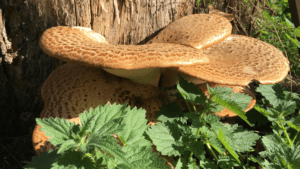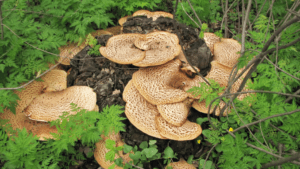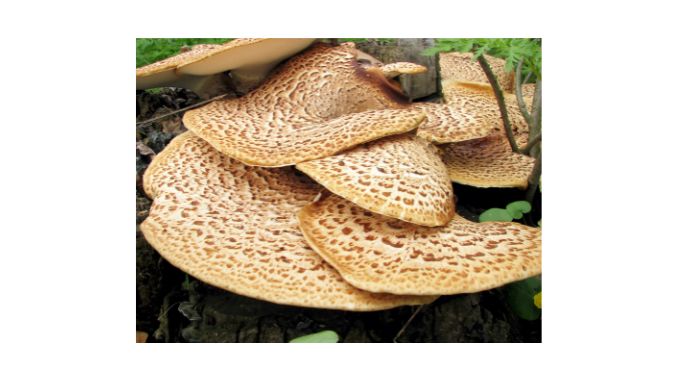Pheasant back mushroom benefits: Quick look
|
Cerioporus squamosus also known as Polyporus squamosus, is a bracket fungus that grows on decaying hardwood logs and stumps. The common name is Pheasant back mushroom. This mushroom has dark brown scales on its cap and is found in North America, Australia, Asia, and Europe, commonly seen east of the Rocky Mountains. It causes a white rot in hardwood trees, both living and dead, and helps decompose wood, making it an important player in the woodland ecosystem. It is an annual mushroom that grows in clusters or alone (2). Pheasant back mushroom benefits are anisomerous and wound healing.
Classification
| Kingdom | Fungi |
| Division | Basidiomycota |
| Class | Agaricomycetes |
| Order | Polyporales |
| Family | Polyporaceae |
| Genus | Cerioporus |
| Species | C.squamosus |
Common name
Some of the commonly used names for this mushroom are
- Dryad’s saddle
- Pheasant’s back mushroom
Synonyms
Polyporus squamosus
Appearance

1. Cap
The cap of this mushroom is semicircular, kidney-shaped, or fan-shaped. About 5-30 cm across and 1–4 cm thick. The color is dry pale to creamy yellowish. Radially arranged brown–blackish scales are present. Initially, a thin margin is incurred later it becomes even.
2. Stem
The stem is thick, 2- 8 cm long. The above part is white, with velvety, dark brown to black tomentum at the base.
3. Pore surface
whitish to creamy when young, on maturity pores become large, angular, irregular, and yellowish. The tube layer is 1.5 cm deep.
4. Flesh
Young flesh is soft and thick, on maturity it becomes corky and tough. White in color.
5. Odour
The smell resembles watermelon rind.
6. Taste
Mild nutty flavor
Spores
spores are smooth, subcylindrical to long ellipsoidal. 11- 15 x 4-5 μm. Dimitic hyphal system (2).
Spore print
spore prints are white
Note: Cerioporus squamosus looks similar to the polyporus tuberastre, piptoporus betulinus and polyporus mcmurphyi. But can be identified by its dark brown scales. so do not confuse – Cerioporus squamosus , if collected for eating.
Bioactive compound present in Cerioporus squamosus
The following are the main bioactive compounds that are present in this mushroom. Alanine, Ethanedioic acid, L- valine, Glycerol, L -isoleucine, L- threonine, Erythritol, Meso-erythritol, 2– deoxy ribitol, Dodecanoic acid, Xylitol, Tetradecanoic acid, Sorbitol, 2,2’-oxybis, Pentadecanoic acid, Hexadecanoic acid, 2-hydroxy propanoic acid, Octadecanoic acid
Nutritional value
The nutritional value per 100g is
| Carbohydrate | 74.22 g |
| Protein | 18.7 g |
| β-tocopherol | 114.7 μg |
| Malic acid | 2.21 g |
Out of total fatty acids, 57% is polyunsaturated and 24.96% is monounsaturated. Β- carotene -1.41 mg/Ml
Pheasant back mushroom benefits
Pheasant back mushroom offers numerous health benefits. It has been found to have potent antioxidant and antimicrobial properties, making it useful in preventing tumorous growth and inhibiting the growth of skin cancers, brain tumors, and neoplasia.
The extract of this mushroom contains important amino acids that can help repair tissue and accelerate the secretion of insulin, the regeneration of protein, and the transport of amino acids into cells. These metabolites also aid in wound healing.
Other medicinal benefits are diuretic, antimicrobial, immuno-enhancing, anti-inflammatory, hepatoprotective, and nephroprotective.
The metabolites extracted from Cerioporus squamosus are used as raw materials for making various medicinal products, including oral hygiene products. Overall, this mushroom has a wide range of potential therapeutic applications due to its many beneficial properties, making it a valuable addition to the field of natural medicine.
Also shows high antioxidant and antimicrobial properties. It is helpful to prevent tumorous growth. Many important amino acids are isolated from the extract of Cerioporus squamosus that may inhibiting the growth of many human skin cancers, brain tumors, neoplasia, etc.
The metabolite present in the Cerioporus squamosus hydromethanolic extract helps in wound healing by repairing the tissue of the human body. These metabolites are also effective in accelerating the secretion of insulin, regeneration of protein, and helping amino acid transport into cells.
Additionally, Cerioporus squamosus has other benefits such as diuretic, antimicrobial, immuno-enhancing anti-inflammatory, hepatoprotective, and nephroprotective.
The metabolites extracted from this mushroom are used as raw material for making medicinal products such as oral hygiene products (1).
Pheasant back mushroom benefits
1. Probable wound healing activity
The mushroom Cerioporus squamosus shows wound-healing activity. Studies done on Human skin fibroblast (BJ-1 cells) show that the extract of this mushroom helps in the migration of fibroblast cells. The main function of fibroblast cells is they help in the formation of connective tissues thus important for wound repair and healing(1).
2. Used as an oral hygiene product
The xylitol which is isolated from the Cerioporus squamosus hydromethanolic extract shows various biological activities (3). Because of its anti-inflammatory properties, it is commonly used as an oral hygiene product (4).
4. May have Co-therapeutic activity
One of the important compounds isolated from the hydromethanolic extract of this mushroom is β- alanine, which shows its co-therapeutic activity for the treatment of breast tumors and may reduce the metabolism of the cancerous cell along with the reducing the extracellular acidification that causes the suppressed aggressiveness (5).
Side effect
There is no such side effect of consuming Cerioporus squamosus, it is considered a good edible mushroom if consumed young and just after picking it.
Although this mushroom is not poisonous mature mushrooms are firm and rubbery hence not taste good hence can not be eaten.
How to eat

Just like other mushrooms, Cerioporus squamosus can be eaten either stir-fried or in soup.
There are no side effects of this mushroom. Best to consume this mushroom when they are young as a mature mushroom does not taste good due to its rubbery texture.
always clean this mushroom before eating them. After cleaning can simply sautee them in a pan with oil and chopped onion and garlic.
